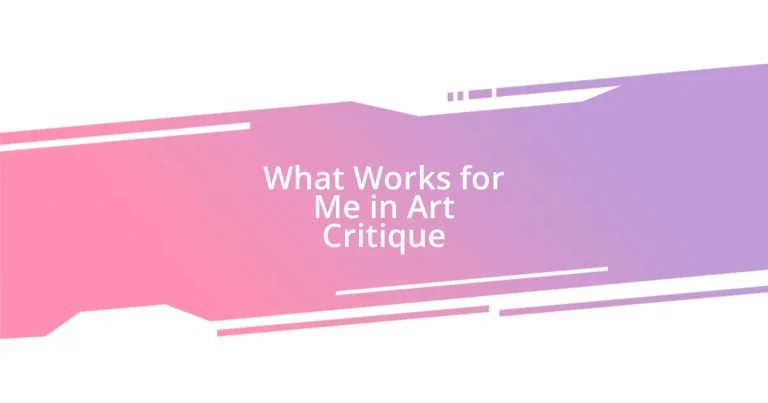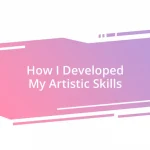Key takeaways:
- Art critique is a dialogue that fosters growth for both the artist and the observer, emphasizing the importance of context, positive acknowledgment, and constructive feedback.
- Effective critiques focus on specific elements such as composition, color, technique, and theme, enhancing discussions and deepening understanding of the artwork.
- Building a supportive critique community encourages vulnerability and openness, transforming feedback into collaborative exploration and strengthening artistic connections.
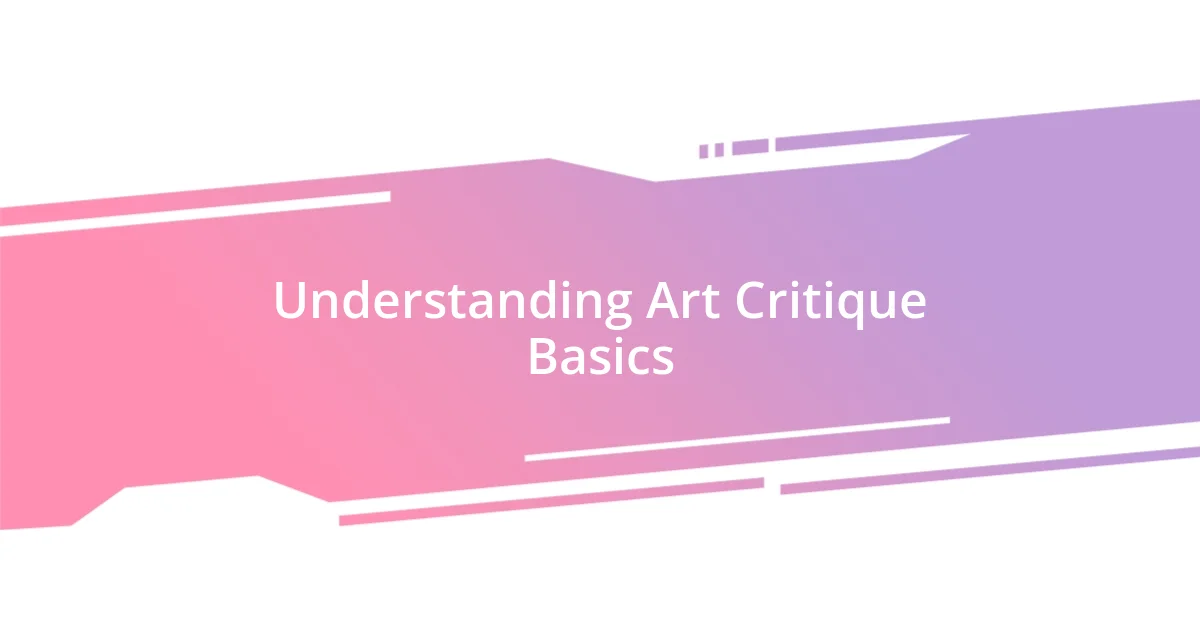
Understanding Art Critique Basics
Art critique isn’t just about pointing out flaws; it’s an opportunity to dive deep into the emotional and conceptual layers of a piece. I remember my first critique session in art school—my heart raced as I watched peers dissect my work. It felt vulnerable, but it was also enlightening. Have you ever wondered how feedback can shape your creative process?
One essential aspect of art critique is learning to articulate your thoughts clearly and respectfully. During one critique, I struggled to express why a particular piece resonated with me. But when I found the right words, it opened up a rich dialogue that deepened my understanding. It made me realize that each critique is not just a judgment but a conversation that helps both the artist and the observer grow.
Additionally, understanding the context—like the artist’s background and the historical influences on their work—can dramatically enhance your critique. I once critiqued a friend’s piece and learned so much from the story behind it, which changed my perspective completely. Isn’t it fascinating how context can shift our interpretation? This element not only enhances our appreciation but also enriches our discussions about art.
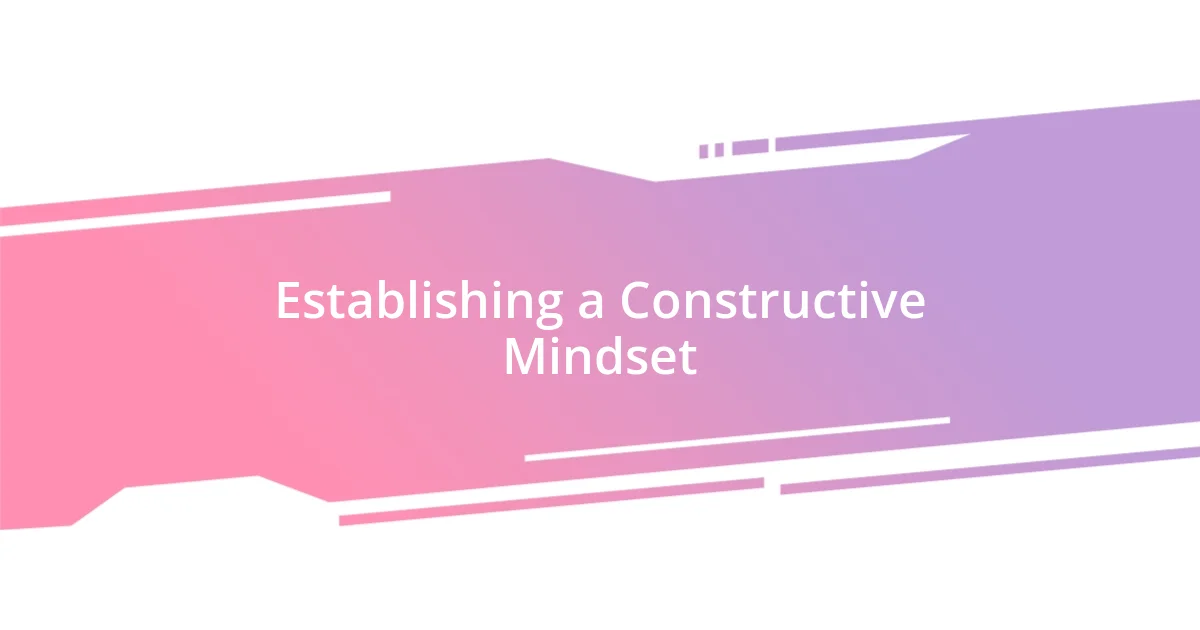
Establishing a Constructive Mindset
Establishing a constructive mindset is vital for both giving and receiving art critiques. I recall a session where I had to provide feedback on a classmate’s work. Instead of jumping straight to what I felt didn’t work, I began by acknowledging the parts of the artwork that spoke to me. This simple shift transformed the environment into one of openness and support, which ultimately made the critique feel like a collaborative exploration rather than a harsh evaluation.
When critiquing, it helps to focus on the “why” behind your thoughts. During a group critique once, I asked my peers to explain the reasons behind their opinions. This not only nurtured deeper conversations but also helped everyone articulate their perspectives more clearly. By cultivating a mindset centered on understanding rather than judgment, I’ve found that critiques can become insightful learning experiences for all parties involved.
Adopting a mindset that embraces the potential for growth is essential. I’ve learned that every critique, even the difficult ones, offers room for improvement. I remember the sting of receiving tough feedback on a piece I loved. Initially, it hurt, but reflecting on those comments ultimately led to my strongest work yet. How do you navigate tough feedback? Instead of shutting down, I’ve found it’s most beneficial to lean in and explore the suggestions further.
| Constructive Mindset | Non-Constructive Mindset |
|---|---|
| Focus on positives and growth opportunities | Highlight flaws and reject any possibility for advancement |
| Encourage an open dialogue | Shut down discussions with judgment |
| Articulate “why” behind feedback | Offer vague opinions without support |
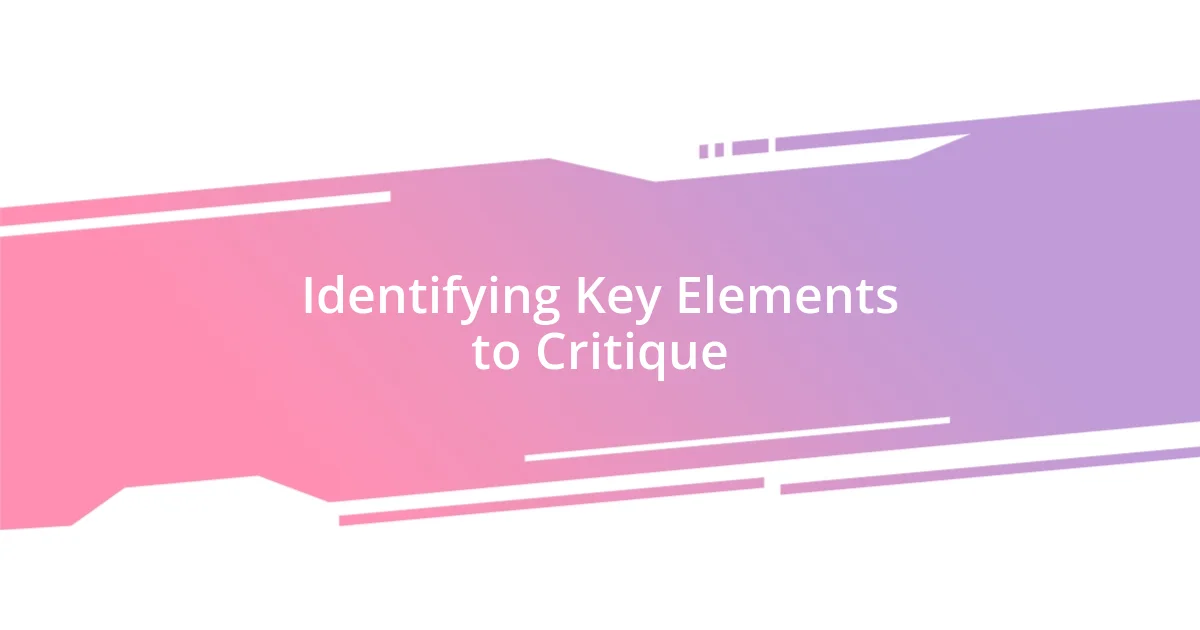
Identifying Key Elements to Critique
Identifying key elements in a piece of art to critique can make all the difference in fostering a meaningful conversation. For instance, I vividly remember the moment I fixated on the color palette of a friend’s painting—the hues instantly evoked feelings of warmth and nostalgia. This attention to color not only shaped my critique but also opened up discussions about emotional resonance and intent. By focusing on specific elements, I realized we craft not just critiques but a deeper understanding of art itself.
Here are some crucial elements to consider when critiquing art:
- Composition: How the arrangement of elements within the artwork guides the viewer’s eye.
- Color and Light: The use of color schemes and lighting to evoke emotions or convey meaning.
- Technique: The methods and materials used by the artist that affect the work’s overall impact.
- Theme and Narrative: The underlying message or story the artwork explores.
- Context: The background of the artist and the historical influences that shaped the work.
By honing in on these aspects during critiques, I find that discussions become richer and more engaging, leading to insights that benefit both the artist and the observer alike.

Techniques for Effective Feedback
Focusing on the specific aspects of an artwork when giving feedback allows for a more productive dialogue. I recall a time when I critiqued a sculpture and zeroed in on its texture. Discussing how the roughness of the surface contrasted with the smoothness of certain features led to an intriguing conversation about the artist’s intention. Were they trying to evoke a sense of tension or harmony? By pinpointing those elements, I was able to offer insights that resonated deeply with the artist’s vision.
One effective technique is to ask open-ended questions. During a critique session, I remember asking my peers, “What feelings does this piece evoke for you?” This simple question sparked a vibrant discussion that illuminated different perspectives and interpretations. It reminded me that art is deeply personal, and encouraging others to share their emotional responses can enhance the critique process. Isn’t it fascinating how a single piece can elicit a multitude of experiences?
Another approach is the “sandwich method”—offering a positive comment followed by constructive feedback and concluding with more positives. I once used this approach when critiquing a whimsical illustration. I praised the vibrant colors first, then suggested enhancing the character’s expression for more impact, and finally reiterated how the playful style made the piece enjoyable. This balance helped soothe the artist’s nerves while still providing meaningful guidance. Isn’t it empowering to know that the way we deliver feedback can make all the difference?
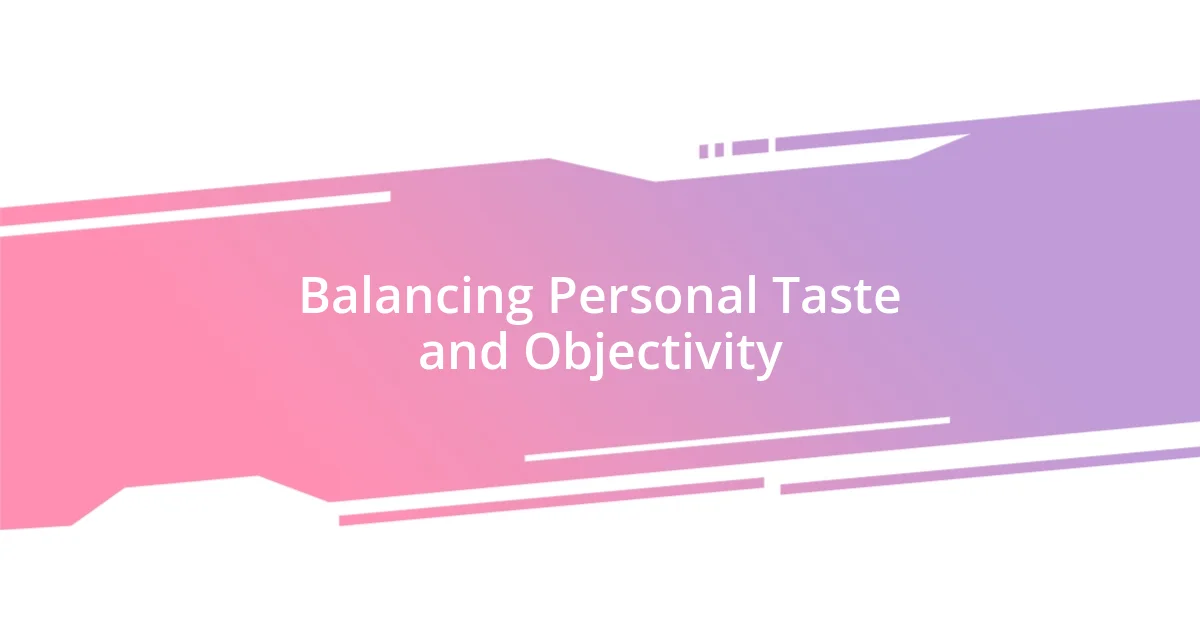
Balancing Personal Taste and Objectivity
Balancing personal taste with objectivity in art critique is like walking a tightrope; it requires a delicate touch. I’ve found myself in situations where my love for abstract art clouded my judgment of a more traditional piece. While my heart wanted to gush over the colors and brushwork, I had to step back and consider the artist’s intention. How can we truly appreciate different styles if we only see through the lens of our preferences?
As I reflect on past critiques, I recall a time when I assessed a contemporary piece that didn’t gel with my tastes. Instead of dismissing it outright, I chose to explore its context. I learned about the artist’s background and the societal issues they were addressing, which added layers to my understanding. It dawned on me: can we really critique art without considering the context in which it’s created? This experience taught me that objectivity doesn’t mean suppressing personal taste; it’s about acknowledging it while exploring the broader narrative.
Through this balance, I strive to cultivate a dialogue that respects both the artist’s vision and my perspective. I remember a critique session where someone passionately defended a piece I found unappealing. Instead of countering, I listened—and found my viewpoint shifting. Isn’t it incredible how engaging with different opinions can lead to growth? In the end, the beauty of art critique lies in this interplay, where personal taste and objectivity can harmoniously coexist.
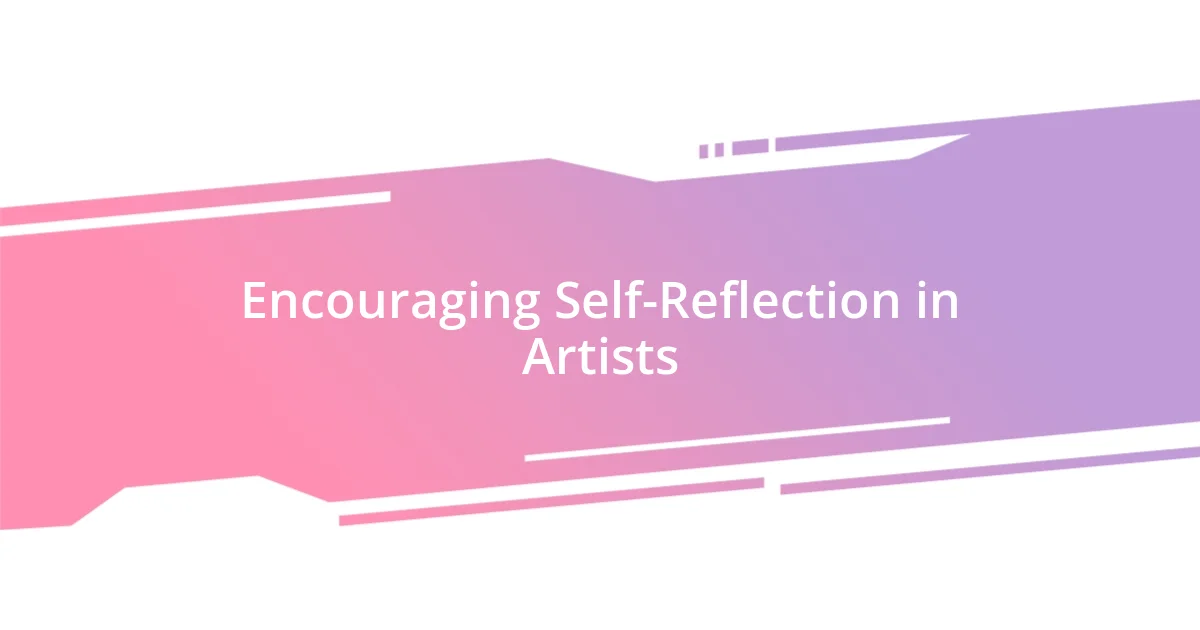
Encouraging Self-Reflection in Artists
Encouraging self-reflection in artists is something I’ve found to be a transformative process. During a critique of a series of paintings, I noticed an artist struggling to articulate their intent. I took it upon myself to gently lead them through their thought process by asking, “What does this piece mean to you?” This simple question opened the floodgates of their creativity, enabling a dialogue that not only deepened their understanding of their work but ignited a newfound confidence. Isn’t it amazing how a little nudge can help someone discover their own voice?
I also believe that encouraging a reflective mindset can enhance an artist’s growth. In a recent workshop, I introduced an exercise where each artist revisited a piece they created months earlier and wrote down their thoughts on its strengths and weaknesses. This exercise was eye-opening for many, as they grappling with their previous choices led them to realize how much they had evolved. Have you ever revisited your old work and felt a mix of pride and awkwardness? It’s this blend of emotions that can fuel artistic innovation.
Lastly, I sometimes ask artists about the emotions they want their audience to feel. During one critique, I urged a painter to share the story behind a particularly dark piece. As they spoke, I watched their eyes light up with passion and conviction. That moment made me realize how essential it is to champion self-reflection; it not only strengthens connection with one’s audience but also enriches the creator’s journey. Isn’t the pathway of self-exploration what makes art truly compelling?
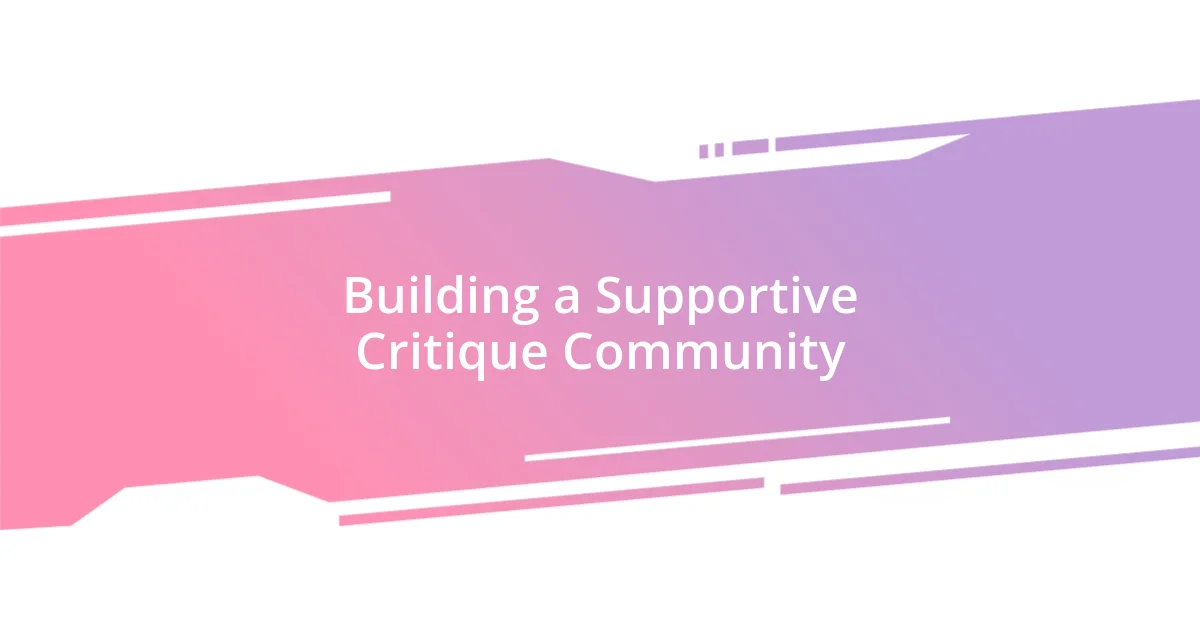
Building a Supportive Critique Community
Building a supportive critique community is essential for fostering growth among artists. I remember attending a critique group where everyone was encouraged to share their thoughts openly, yet respectfully. The atmosphere felt warm and inviting, which made it easier for me to voice my opinions. I realized how critical it is to create a safe space where artists can be vulnerable; without it, honest feedback can feel daunting.
Another experience that stands out to me involved a fellow artist who was reluctant to share their work. I encouraged them by sharing my own struggles with vulnerability in critique settings, highlighting the importance of community support. Isn’t it interesting how mutual understanding can break down barriers? Once they shared, the feedback they received was not only constructive but also uplifting, transforming their perspective on critique into one of possibility and excitement.
Over time, I’ve found that regular gatherings strengthen these connections. I once introduced a monthly critique potluck where each artist brought a dish to share alongside their art. It became a ritual that not only showcased our work but also fostered friendships. Eating and critiquing together made the experience intimate and relaxed. How much easier is it to give and receive feedback when we’re breaking bread together? That simple act turned our critique sessions into vibrant collaborations, reminding me that building a community goes beyond just exchanging critiques; it’s about cultivating relationships that nurture our creative spirits.












